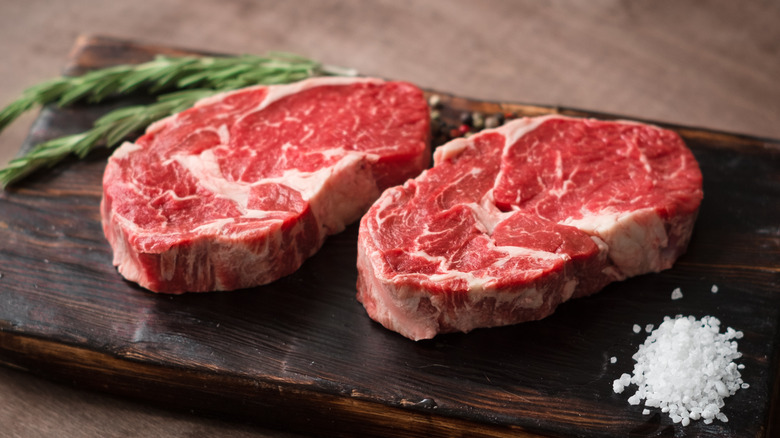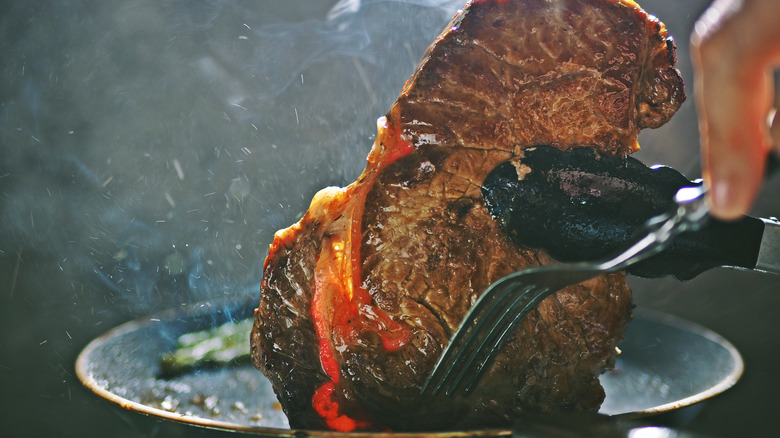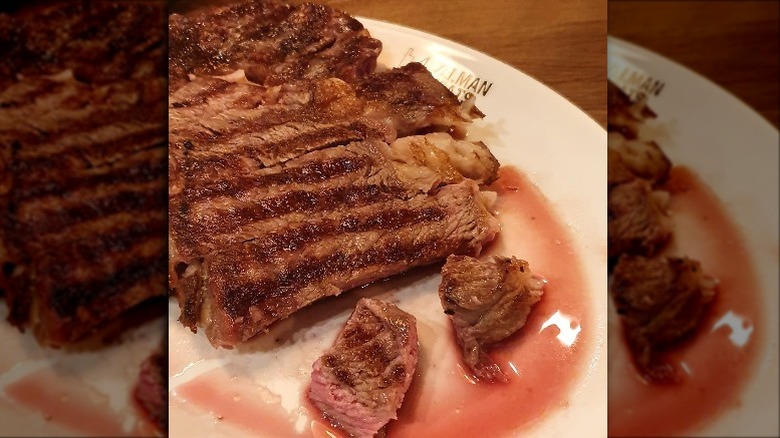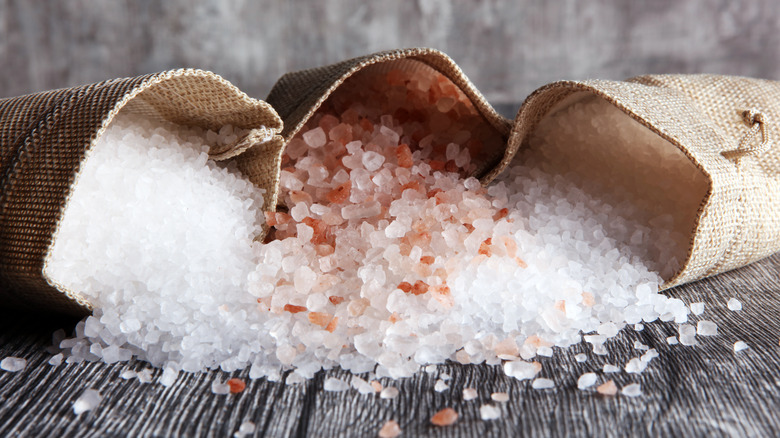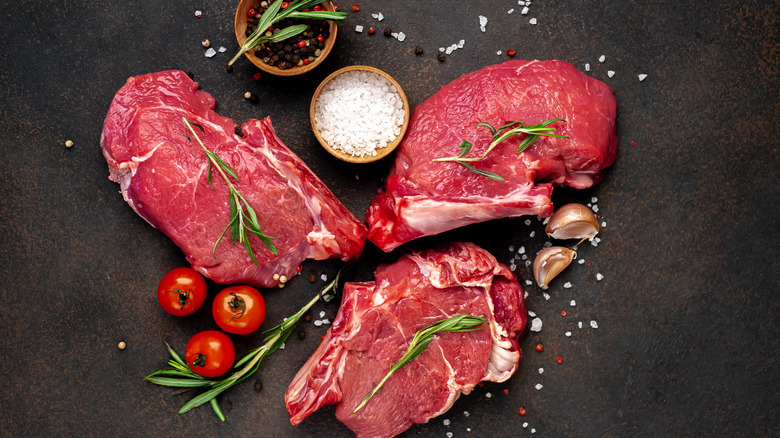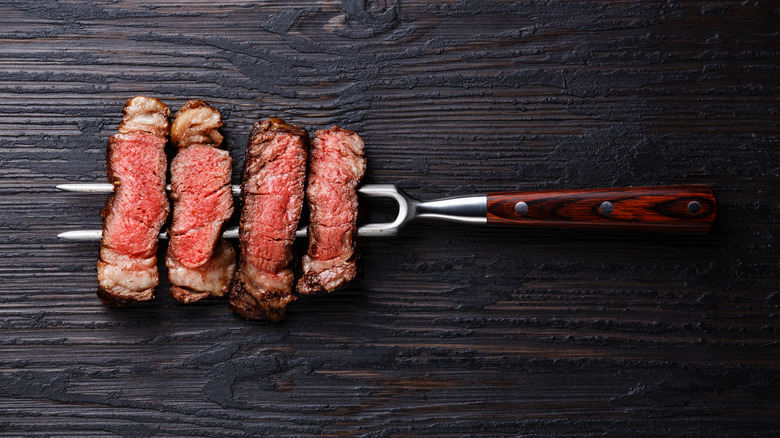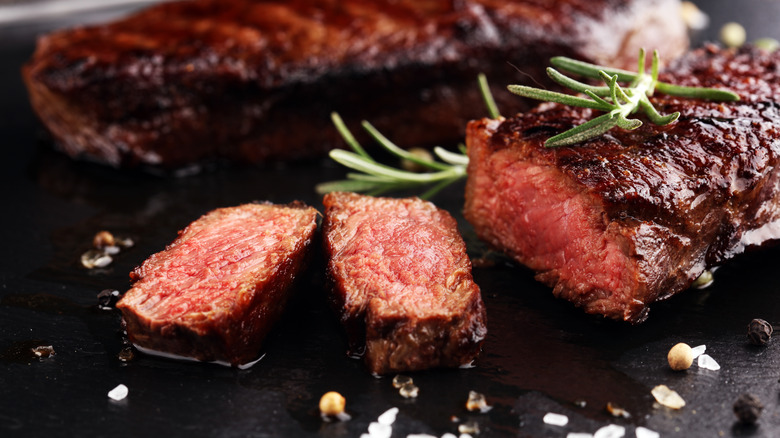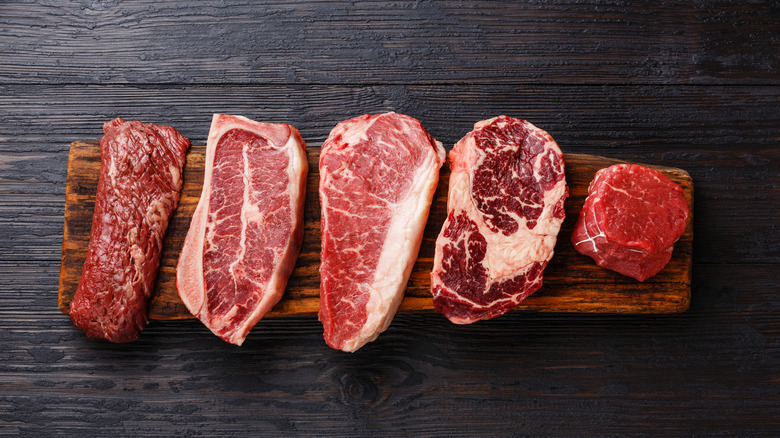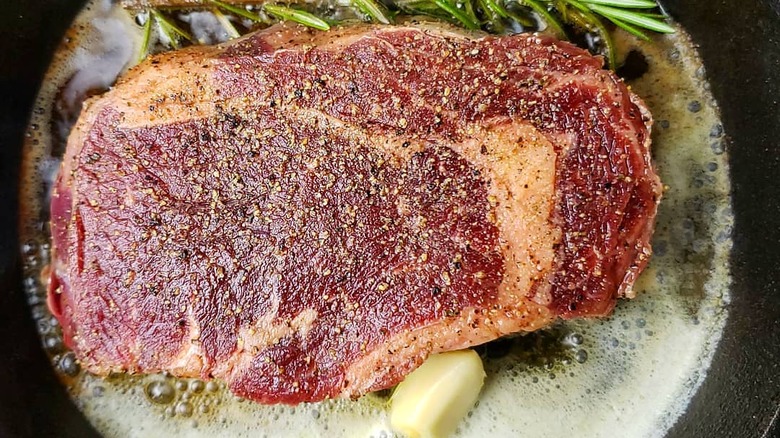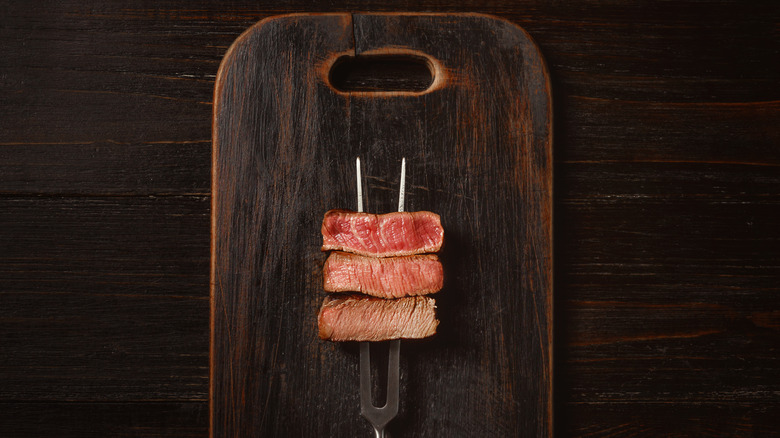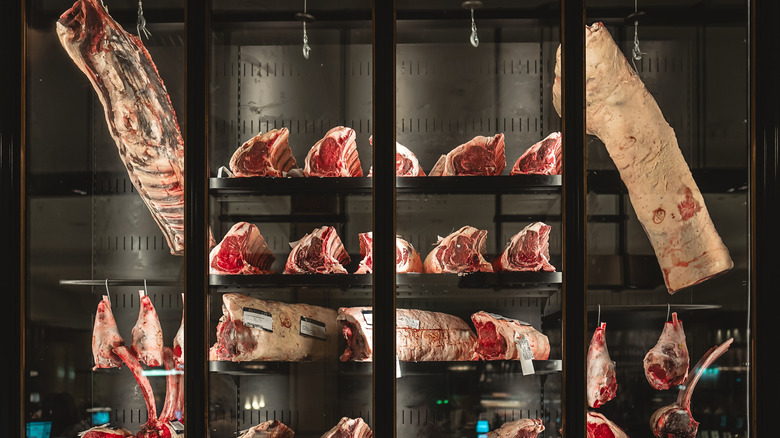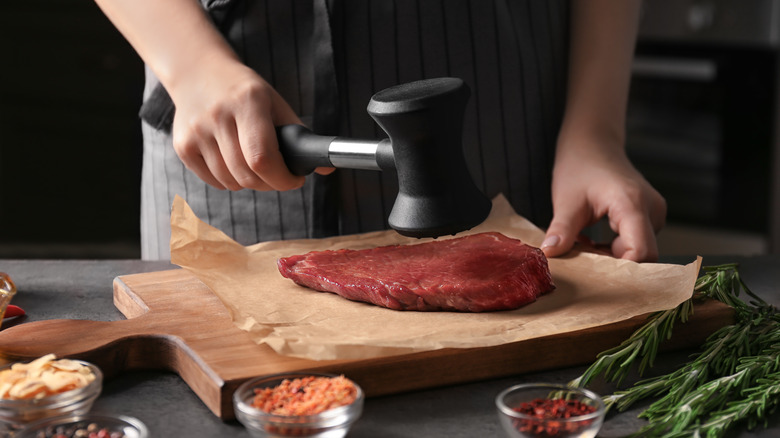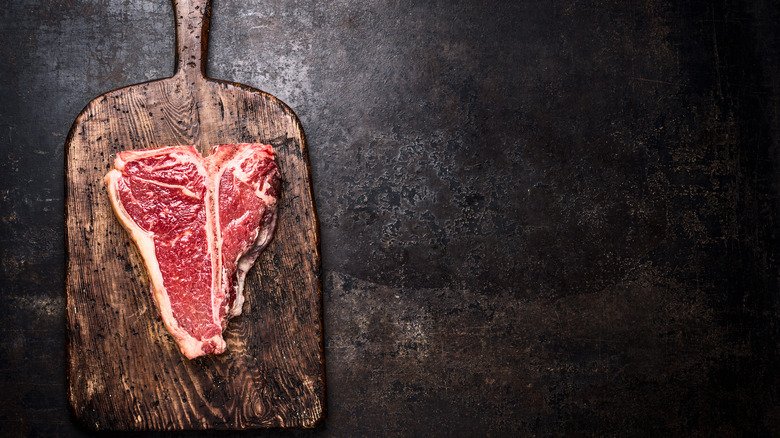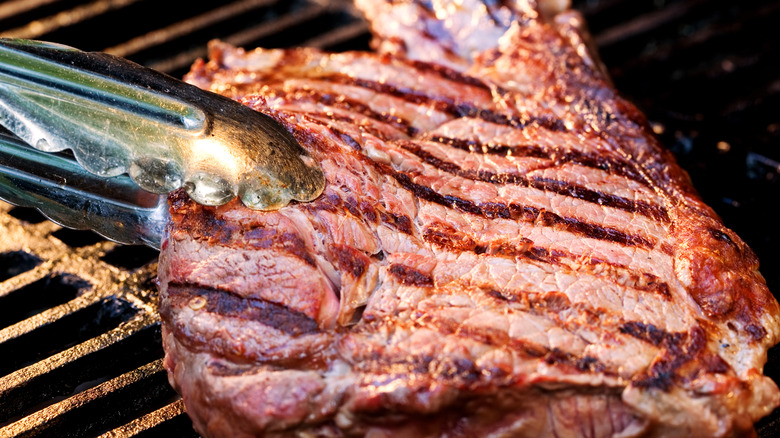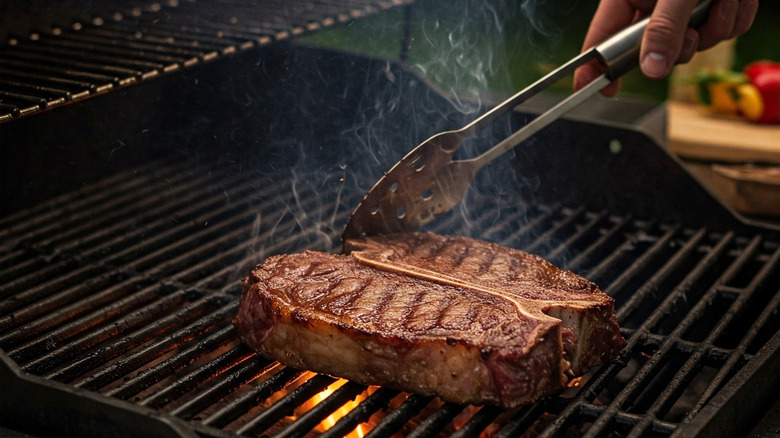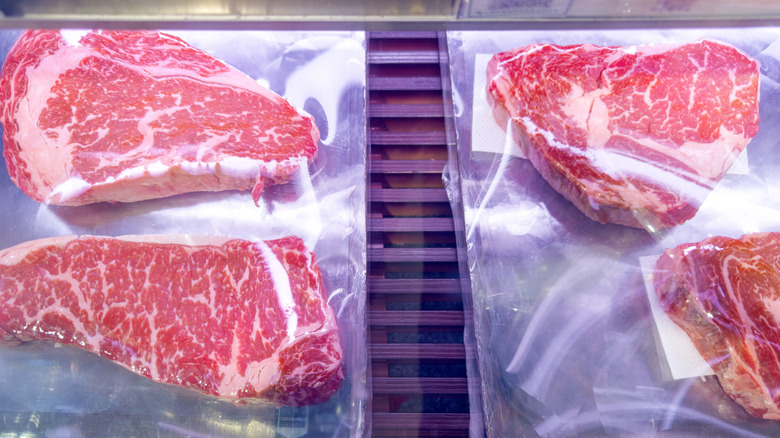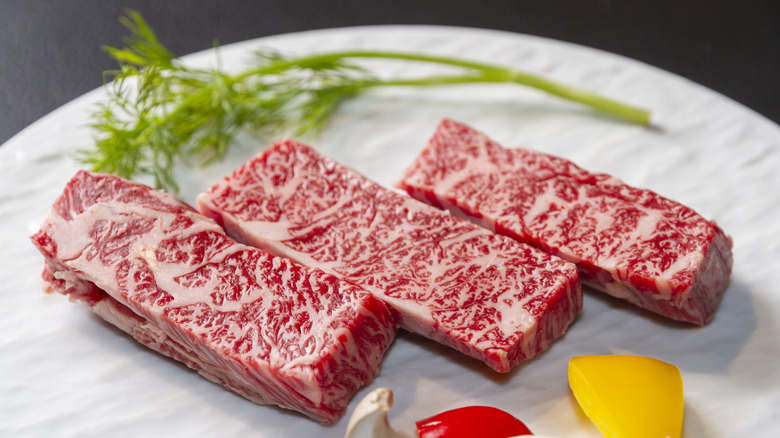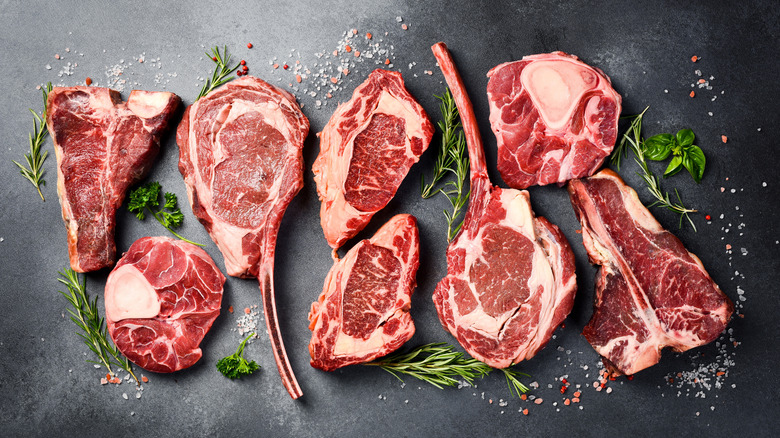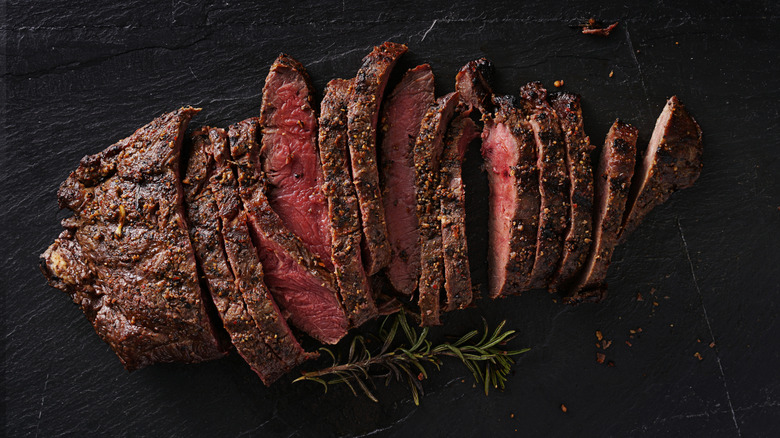The Common Myths About Steak That Are Actually False
Many consider the ability to cook a tender, juicy steak the mark of a good cook. Not only is a well-cooked steak delicious, it can also be quite expensive depending on which cut you choose. Because of the high price tag on many cuts of meat, there's pressure on the home cook not to mess it up. Out of this quest to cook the perfect steak is born a myriad of steak-cooking myths, various do's and don'ts that some swear by and others raise an eyebrow at.
You may know how to cook the perfect steak, but there's still a good chance you believe at least some of the most pervasive steak-cooking myths out there. If you take these myths as fact, you could be wasting a significant amount of time in the kitchen — or you could just end up with a less-than-perfect steak. Take a look at some of the most common myths posing as legitimate wisdom when it comes to making a top-notch steak, and take your steak game to the next level.
These are the common myths about steak that are actually false.
Searing steak seals in the juices
How many times have we heard celebrity chefs on television tell us to sear the meat to "seal in the juices"? Unfortunately, this is a big myth, as that's not at all how searing works.
The idea that searing the outside of meat somehow kept the juices inside of it was first propagated, according to Meathead's AmazingRibs.com, by German chemist Justus von Liebig in 1847. While, by the early 1900s, the concept had been scientifically debunked, many people still believe it today. So, let us be clear: searing does not seal anything into your steak. That said, it's far from a useless endeavor.
Searing meat is the best way to cause the very flavor Maillard reaction to occur, also known as the science of holy-heck-that's-a-delicious-steak. This set of reactions between amino acids and sugars is what makes the steak turn brown on the outside and become deeply flavorful and caramelized all over. So searing might not seal in the juices, but it is indeed useful when cooking a delicious steak.
The red liquid coming from your steak is blood
One aspect of eating a steak that can really turn some non-red meat-lovers off is the pinkish-red liquid that oozes out of a juicy steak. It can be unsettling, because, yes, it does kind of look like blood. In fact, we often call a very rare steak "bloody." The idea alone can turn the stomach of a less-than-adventurous eater. Any steak will leak this liquid, but the bright color is more pronounced in a rarer, redder steak.
However, you won't find blood even in the rarest of steaks. The liquid coming out of a cooked steak is actually called myoglobin, and it's a protein in animal tissue. Myoglobin serves to deliver oxygen to the muscles of an animal. Luckily for every steak-lover out there, it's safe to eat and doesn't have anything to do with blood. The myoglobin in a steak will darken as it's cooked, which is why a rare steak looks a lot "bloodier" than a more well-done steak. All that juiciness is part of what makes a well-cooked steak so enjoyable, so embrace it and soak all that juice up with a starchy side dish.
Don't salt your steak before you cook it
If you want just about any meat to be more flavorful, it's a good idea to salt it before you start cooking it. Most people know this, yet the myth that it's bad to salt your steak before cooking is still pervasive. However, there's generally not a lot of information about exactly why steak should supposedly be salt-free before it hits the skillet or the grill.
Perhaps that's because there's no good reason not to salt your steak. Not only does the salt bring out more flavor from the meat, but salt is also important for a process called dry brining. The salt dries out the surface of the steak, making it easier for you to achieve that perfect sear that's sure to make mouths water. According to Smoked BBQ Source, it's best practice to salt your steak about 40 minutes to two hours before you're ready to start cooking it. If you forget to plan ahead, you can also sprinkle some salt onto the steak right before you put it in the pan.
One mistake you don't wait to make, though? Salting your steak five to ten minutes before you start cooking. At that point, the salt will have brought the moisture to the surface of the steak, but it won't have had enough time to dry out. This will make it more difficult to get that beautiful crust all steak-lovers live for.
All salt does for a steak is add flavor
Seasoning a steak with salt is certainly important to help bring out its best flavor, but using salt is not just a matter of improving the flavor of your steak. Salt also serves to tenderize meat.
According to the outlet, seasoning the outside of meat draws out its water content. This moisture is then seasoned with the salt on the surface of the meat before it is eventually reabsorbed back into the steak, kind of like a dry brine. This process tenderizes the meat and effectively seasons it from the outside in.
It's for this very reason that many experts recommend seasoning grass-fed meat, according to Pineshine Farms. Cuts from grass-fed animals tend to be tougher than corn- or grain-fed meat. They typically need at least one hour (and sometimes even longer) to sit with some salt before being cooked. The result will be a tasty, perfectly seasoned steak that also boasts a wonderful texture — and no meat mallet is necessary.
It's bad to stick a fork in your steak before you're ready to eat
This myth makes a lot of sense at first glance. The reasoning behind it is this: Sticking a fork in your steak before it's on your plate only lets the juices run out of it — juices you want to be "sealed" inside. Yes, of course, you might lose some of those juices when you stick a fork in it, but it's not going to make a difference when it comes to taste or tenderness. Want to flip your steak with a fork? It may not be conventional, but we don't judge, and it's not going to ruin your steak. (But, you know, keep the fork holes to a minimum.)
Not only is stabbing your steak with a fork before you sit down to eat not a sin, but you may even want to take it a step further. While you can never truly know if your steak is fully cooked without using a meat thermometer, checking the color of the inside of your steak by cutting it open can give you an idea of how long you need to leave it on the heat. It may not result in the prettiest, most flawless steak, but it can help amateurs get a feel for how to cook a steak specifically to their liking.
You can tell if your steak is done simply by poking it
There are so many myths about how to determine a steak's doneness. Just looking at the color can give you a sense of how done it is, but if you like your steak rare, you're going to need more than a quick color check. There's the "poke test," where you poke your steak to determine how much give it has. The firmer it is, the more done it's supposed to be, according to legend. But let's be real: This method just doesn't work.
Everyone is different, and it may feel different to poke your palm than it does for another person. Plus, you have to consider the lack of accuracy here. Even a temperature difference of five degrees could make a big difference in the matter of food safety, and there's no way your finger has enough intuition to tell the difference. Instead, the best way to find out if your meat is cooked is to use a meat thermometer. Instant-read thermometers are the way to go, as they're accurate and give you a reading immediately. It's a small investment that's worth it if you want to get a perfectly cooked steak every time.
A fillet is the only way to go
Everyone seems to have an opinion about the best cut of meat to get if you want a top-quality steak, but fillet is always a top choice. Some, in fact, believe it's the only kind of steak you should even bother with. But if you adopt this attitude, you're going to miss out on a lot of variety — and some amazing culinary experiences. Fillet is more tender than other cuts, which is a big bonus. But cuts like a ribeye or a sirloin are going to offer a fattier, richer taste since they have more fat marbling.
The benefits of branching out and trying different cuts of meat are manyfold. First of all, a fillet is the most expensive kind, so if you opt for something different from time to time, you may save some cash on your steak. And those who are trying to improve their cooking skills will benefit from working with different cuts of steak. Moral of the story? Don't limit yourself.
You should always cook your steak in butter
If you're passing up the grill for your skillet when it's time to cook your steak, you may wonder what kind of fat you should be using to sear your piece of meat. Olive oil is a popular choice here, as is butter. These options can be delicious, but they aren't the only options out there. Those who really want to give their steaks a kick of extra flavor might want to opt for an alternative: beef fat. Can't find beef fat at your local store or market? It's actually possible to render beef fat yourself if you have the patience.
When your pan heats up, you can add a bit of beef fat to the bottom. Just keep in mind that you don't want to use too much fat at the bottom of your pan, or you may end up boiling your steak (which, gross). Instead, it's possible to simply brush beef fat directly onto your steak. And yes, that tastes just as delicious as it sounds. Looking for even more flavor? Add some herbs to the fat for a bit more depth to the dish.
Never use sauce on steak
Not long ago, putting sauce on a steak wasn't quite the crime that it is today. Catching a glimpse of an A.1. Steak Sauce bottle at a steakhouse wasn't grounds to leave the restaurant entirely — it might even be expected. But times have changed. It's generally accepted that a good steak should under no circumstances find itself smothered with sauce, taking away from the true taste of the meat. In 2014, in fact, A.1. actually removed the word "steak" from its label, hoping that customers would pair it with other foods besides steak, rather than ditch it entirely.
Consumers have rejected traditional steak sauces for good reason. These sauces can largely mask the taste of a high-quality steak (and why eat one that's subpar, anyway?) instead of bringing out its true flavor. But that doesn't mean you should ditch the sauce entirely. An alternative to heavier sauces is a light chimichurri sauce. Chimichurri hails from Uruguay and Argentina, where a beef-heavy diet is common. Rather than covering the taste of steak, a nice, herbaceous, vinegary chimichurri will highlight all its strengths. Plus, you don't have to go out to buy a bottle of this stuff: It's 100 percent better when it's homemade.
Well-done steak is safer to eat
If you thought you needed to cook your steak until it was grey inside to ensure it was safe to eat, guess what? According to the BBC, scientists from the University of Nottingham found that, on the contrary, rare meat is perfectly safe to eat. Well, provided that clean utensils are used to prepare it.
The study, for which scientists spiked samples of raw meat with E. coli before cooking, found that the bacteria only survived where the meat was recontaminated post-cooking with unwashed utensils that had been in contact with the raw meat. The rare pink center was perfectly safe to eat.
It bears mentioning that, while this finding holds well for single cults of meat like steak, the same does not apply to burgers or other ground meat products. The researchers say ground meat should be cooked all the way through to prevent any food borne illness. Per the USDA, ground meat should be cooked to a minimum internal temperature of 160° F to ensure it's safe to eat.
Fresher steak is better steak
It might seem like fresh steak is a no-brainer, as no one wants to eat old meat, right? But while you definitely shouldn't be cooking up steak that's been sitting in your fridge long past its sell-by date, the line may be a bit further along than you think. If you've enjoyed the pleasures of a dry-aged steak, you know that things aren't as simple as mere freshness.
Dry-aging beef, according to Steak School, is actually a time-honored technique dating back thousands of years before we could enjoy modern marvels like electricity and refrigeration. During the dry-aging process, beef is exposed to air, which allows some bacteria to form on the surface, preserving the meat within and producing a rich, intense flavor profile.
Don't worry about your health though, as this layer is trimmed off before the steak is cooked and eaten. But this is one very potent example of freshest not necessarily being best! That said, you may want to leave dry-aging to the professionals.
You need a meat mallet to tenderize steak
A meat mallet can be used to flatten uneven cuts of chicken, pork, and, yes, steak, but it also tenderizes the meat. That said, a meat mallet is far from an essential kitchen tool, for more reasons than one. First off, tenderizing steak is only necessary for cuts that aren't already tender in the first place. Don't go whacking your filet mignon with a meat mallet (or risk the ire of Gordon Ramsay, who once lambasted a chef for doing just this on his "Kitchen Nightmares"). Where meat mallets do come in handy is with less pricey cuts like chuck steak, which often have shorter, tougher fibers.
That said, if you don't have a meat mallet, you can also use other tools. A wine bottle works just as well, and a rolling pin will also do in a pinch. But tenderizing steak by beating it into submission isn't the only way to improve its texture, so carefully consider whether or not you really need that meat mallet for a perfectly tender steak.
Steaks need a marinade for better flavor
Lots of steak recipes call for a flavorful marinade, often composed of garlic, onion, spices, and even citrus. However, according to the Los Angeles Times, most marinades are actually pretty useless, adding little to no flavor to an already flavorful cut of meat. Even worse, some marinades can actually cause damage to meat, especially marinades with a lot of acidity in the mix.
The principle behind this is the same as that of using lemon juice to "cook" fish for ceviche or aguachile. The acid denatures the proteins in the meat, making them overly tender or even mealy on the outside without ever penetrating deeper within the cut. The result is meat that may indeed be flavorful but will not have the texture you seek. Additionally, some marinades may burn in the pan and give your dish a nasty final flavor.
If you are going to marinate meat, opt for marinades that are rich in herbs and use olive oil as a base, rather than those that rely on too much acidity like citrus, wine, or vinegar. And if you can, use a dry brine with salt instead of a marinade to season it.
Steaks need to be brought to room temp before cooking
This meat myth is one that many believe, and at first glance, it seems to hold water. After all, if you cook the meat right out of the fridge, it will theoretically take longer for the inside to heat up, leading to a steak that is cooked unevenly. Right? Not so, according to YouTuber Helen Rennie, who used the scientific method to prove that taking your steak out of the fridge an hour before cooking doesn't do you any good. Turns out that wait time isn't worth it, after all.
Cook's Illustrated agrees, noting that starting with room temperature steaks makes no difference in preventing the gray "banding" that can form between the outer crust and rosy pink interior of a medium steak. So what can? According to the outlet, home cooks can simply warm the steaks in a very low oven before searing them. It's a technique called reverse searing that's well worth a try if you want really even pink color and none of that visually unappealing grayness.
You should only flip your steak once
Master grillers will often get ornery if you mess with the meat too much once it's down. They often claim that the only way to get a good sear is to leave it alone until the Maillard reaction can do its magic. And while it is indeed a good idea to let the surface of the steak take on some color before moving it, this doesn't have to be a one-and-done sort of operation.
According to the Los Angeles Times, citing food scientist Harold McGee, more frequent flipping is actually a better way to cook the steak evenly. And, no, you won't miss out on a perfectly charred exterior. McGee tried turning his steak as frequently as every five seconds, though the Los Angeles Times dialed this back to a far-less-frantic approach of flipping it once a minute. The result? An evenly cooked center and a lovely brown crust, all without the worry of overdone or mangled steak. In other words: steak perfection.
Steak is best cooked on the grill
You've probably heard many people say they're going to "throw some steaks on the grill." I know it was a common term in my household growing up. But if you only cook your steak on the grill, you are missing out on a whole other technique that can yield equally delicious results. Cooking a steak on the stovetop and oven leaves you with a perfectly tender and juicy steak without having to sit outside in the elements. Experts recommend a two-step process of searing your steak in a cast-iron skillet and then putting it in the oven to finish cooking completely to get the caramelization without overcooking the steak.
Another reason to forgo the grill when trying to make the best steak is that the heat can be a bit unpredictable. Though you can control the temperature of the grill on a gas grill, you can't always predict if flames will flare up and get closer to the steak, causing hot spots. This, in turn, can cause the steak to become unevenly cooked (even from appearance, as those coveted charred marks can vary from side to side). You also lose out on the opportunity to baste your steak as it cooks if you use the grill, as all that buttery, flavorful goodness drips through the grill grates. Although you don't get the grill marks on the stovetop, the cast-iron skillet does provide that caramelization through the Maillard reaction, resulting in a crisp, delectable crust.
Your grocery store doesn't have good steaks
This myth is one that is much debated, as many experts balk at buying steaks from the grocery store. But what about those of us who are on a budget or don't have access to a quality meat market? Though a specialty butcher may have a wider variety of high-quality meat cuts, don't totally write off your grocery store butcher counter. There are plenty of options at your local supermarket that can fit the bill for a steak dinner, depending on how you plan to cook your steak. A rib, loin, or short loin can be a good pick if you are grilling or pan-searing your steak. Opt for a ribeye or porterhouse steak if you want a juicy, tender steak.
You also want to be sure to pay attention to the labeling on the steaks. You will see labels such as Prime, Choice, or Select. For your best grocery store option, stick with the steaks labeled as USDA Prime. Not only is this the highest grade available, but you likely will notice a difference in the meat itself with more fat marbling, which means more flavor. You can also go to the meat counter to select your cut of meat yourself instead of trying to sift through the pre-packaged options.
Steaks are better from overseas
You have probably seen Kobe or Wagyu beef at the butcher or at a restaurant for a premium price. Japanese beef is much sought-after for its taste, texture, and tenderness. It is also more difficult to source, as it is a smaller cattle industry due to geographical constraints. It's not just Kobe or Wagyu beef that rivals U.S. meats. Other popular beef sources overseas include Europe and South America, with Brazil topping the list of most beef exports.
Though there are certainly numerous options to choose from for your beef, that doesn't necessarily mean you should write off all steaks stateside. Experts say grass-fed and finished meat, which can be more prevalent at smaller farms in the U.S., both have distinct flavors that more than compete with their overseas counterparts. The steakhouse experience is also a huge part of American culture, boasting large portions, high-quality beef cuts, and a certain atmosphere. So, even though certain preferences may lead you to choose steak from overseas, the U.S. can still produce some perfectly tasty options.
Bone-in steaks are better than boneless
When you think of a big, juicy steak, you may conjure up images of gigantic tomahawks or porterhouse, where the bone makes a big appearance. This could be a personal preference based on taste or cooking manner. Bone-in cuts — which, as the name suggests, feature meat that is still attached to the bone — are generally believed to have a richer flavor than their boneless counterparts.
But others say it is not possible for the bone to impart flavor into your meat, as the bones are nearly impermeable. That means that no, the marrow from the bones can't seep into the meat (plus there's a collagen layer preventing that). Some people have even put the bone-in and boneless steaks to a taste test and found that, flavor-wise, they were indistinguishable.
However, that doesn't mean the bone doesn't serve a purpose. The bones in your steak serve as a natural insulator and can help it stay juicy, which is particularly important for slow-cooking and roasting. A bone-in steak also has a great presentation, while boneless cuts can be easier to grill. Choose between bone-in steak or boneless cuts by considering how you plan to cook your meat, the pricing, and your presentation plans.
Steak is best served whole
You can argue that a whole steak is desirable appearance-wise for a steak dinner with all of the fixings. But serving your steak to your guests pre-sliced isn't necessarily taboo. Sometimes, slicing your steak can be its own form of presentation if the meat is marbled like a Wagyu. Thin-sliced beef is key in dishes like stir-fries, beef sandwiches, or if you are serving tacos in a group setting.
Slicing your steak won't necessarily affect the steak when it comes to flavor or tenderness — unless you cut it improperly. If you do decide to slice your steak for your guests, be sure to cut against the grain, or perpendicular to the direction of your steak's muscle fibers. This ensures your meat is tender, easy to chew, and has a desirable texture. You also want to slice your steak when it is out of the pan and has fully rested, so it doesn't release the moisture, which can leave you with a dry steak.
